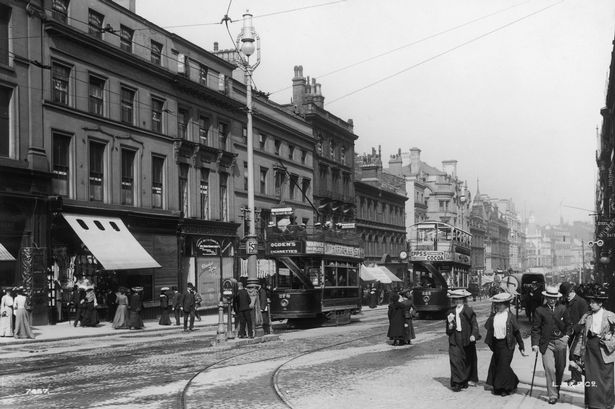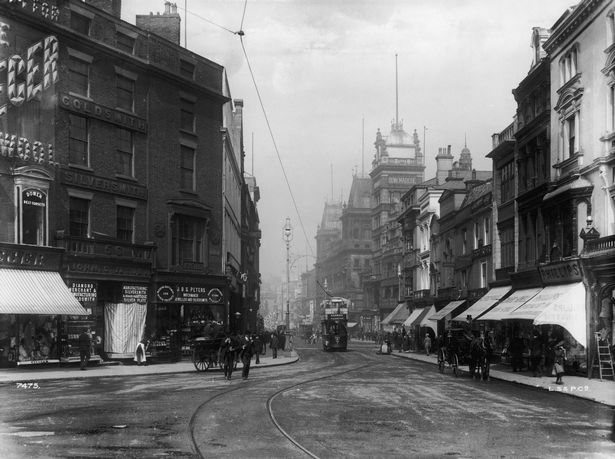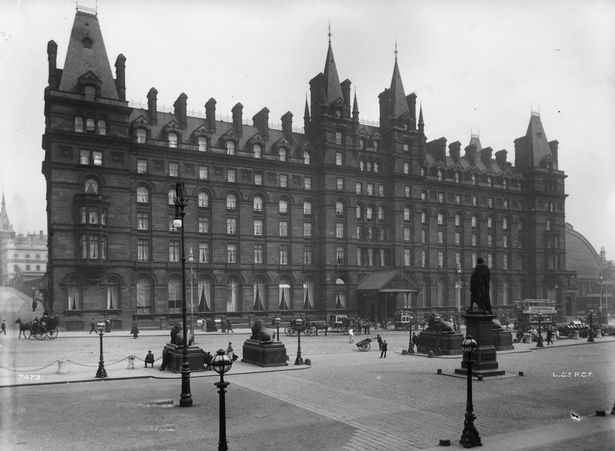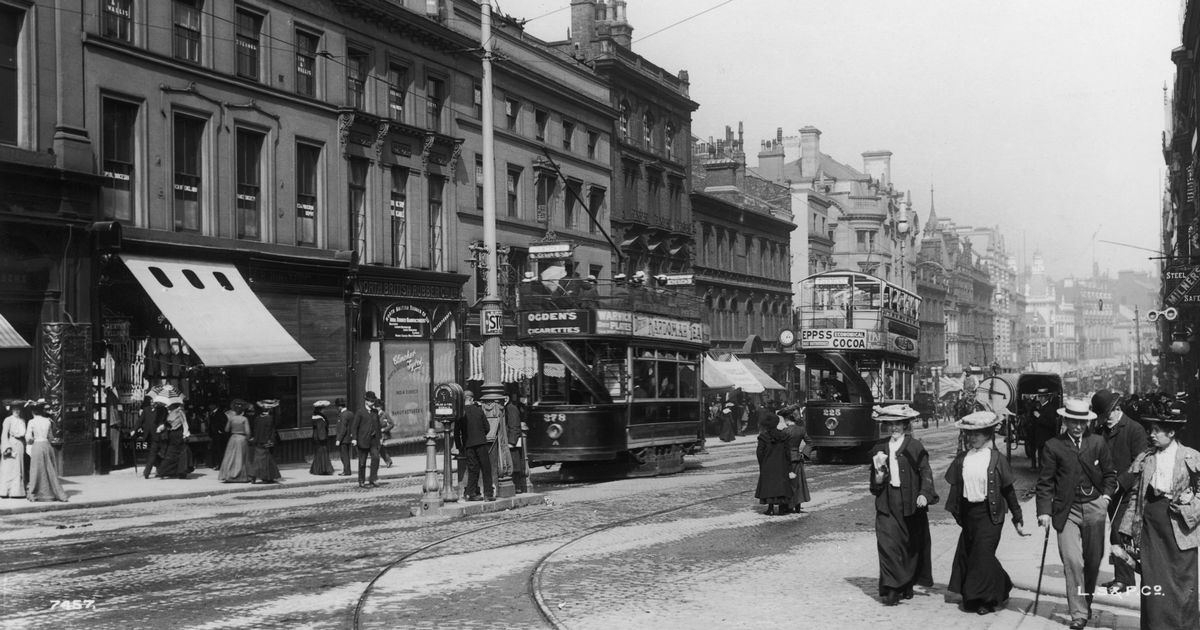Rare images show life in Edwardian Liverpool Lord Street in Liverpool city centre, circa 1903(Image: Photo by London Stereoscopic Company/Hulton Archive/Getty Images)
Lord Street in Liverpool city centre, circa 1903(Image: Photo by London Stereoscopic Company/Hulton Archive/Getty Images)
Fascinating photographs captured well over a century ago offer a glimpse into what life was like on some of Liverpool city centre’s streets decades ago. Back in the early 1900s, Edwardian Liverpool looked unrecognisable in many ways to the city we know today.
A bustling port city, Liverpool was at the centre of trade, seeing its population grow with residents from across the world and its docks and industries continue to expand. For context, the Three Graces – the Royal Liver Building, Cunard Building and Port of Liverpool Building – were getting built, Frank Hornby founded his toy company Meccano and a woman who lived in a “little wooden hut” at the Pier Head was famous across the city.
And these incredible photographs, captured in 1903, offer a glimpse into what life was like in Liverpool 122-years-ago. Unearthed from the Getty archives and courtesy of London Stereoscopic Company/Hulton Archive, they show day to day life in Liverpool on three city centre streets that still exist today.
READ MORE: ‘Tiny’ pieces of history hiding in plain sight inside Liverpool CathedralREAD MORE: Life at 230 year-old building on one of Liverpool’s original streets
Few generations remember Liverpool looking anything remotely like it does in these old photographs. But these images do offer a fascinating window into our city’s incredible history.
The first photograph captures one moment in time on Lord Street. Today, the area continues to be one of the busiest in the city centre and is home to businesses like Boodles, Made to Measure, Rococo Coffee House, Yanni’s fish and chips and brands like Popeyes and Café Nero.
 Church Street, circa 1903(Image: Photo by London Stereoscopic Company/Hulton Archive/Getty Images)
Church Street, circa 1903(Image: Photo by London Stereoscopic Company/Hulton Archive/Getty Images)
But here, Lord Street is bustling with workers and shoppers, all in Edwardian fashions. A standout in the image is the old Liverpool trams and if you look closely – you’ll see one has an advert for both Odgen’s cigarettes and for Kardomah.
Odgen’s tobacco factory on Boundary Lane was once a major employer in the city, while Kardomah, before their cafes became known on high streets across the country, initially started as brand the Vey Brothers tea dealers and grocers, on Liverpool’s Pudsey Street in 1844.
Another photograph shows Church Street in 1903 – which today is home to the likes of Primark, TJ Hughes and River Island. Before the pedestrianisation of the popular street began in March 1974, seeing cars and buses – or in this case trams and horses and carts – among the hustle and bustle of shoppers was part of day to day life.
READ MORE: Life at famous Liverpool dairy where nan has lived for 90 yearsREAD MORE: ‘Boss nights’ at long lost Liverpool festival that was ‘cheap fun’
Again, you can see a tram advertising Odgen’s, but there are also some other incredible pieces of our past hiding in plain site. In the background of this Church Street photograph, you can see Compton House.
A huge fire tore through the original building in 1865, razing it to the ground, and it was rebuilt less than two-years later. It was at this time the world’s biggest department store with five floors until its closure in 1871.
The building was later converted and renamed the Compton Hotel, which operated until 1927. Growing retailer M&S moved into Compton House the following year and made it their flagship store in the city, before its move to the old Debenhams building on Lord Street in 2023.
READ MORE: Lost clock that was an ‘ugly scar’ on famous Liverpool landmarkREAD MORE: Liverpool Sainsbury’s supermarket prices in 1982 shows how much has changed
Next door in the image, you can also see signage for Bon Marche. According to brand John Lewis, the store was designed upon the famous Bon Marche based in Paris.
Bon Marche originally opened to tailor for the emerging middle classes of the late 19th century, but by the early 1960s it merged with George Henry Lees. Our third photographs shows Lime Street, in a view taken from outside St George’s Hall.
You can see out onto St George’s Plateau and people with horse and carts, as well as workers with wheelbarrows and others making their way through the city. In the far right, you can see Liverpool Lime Street Station.
 The London North Western Railway Hotel in Lime Street, Liverpool(Image: Photo by London Stereoscopic Company/Hulton Archive/Getty Images)
The London North Western Railway Hotel in Lime Street, Liverpool(Image: Photo by London Stereoscopic Company/Hulton Archive/Getty Images)
But the main landmark in the image is the LNWR (London and North Western Railway) Hotel. Completed in 1871, the building was designed in a Renaissance style by Aigburth -born Alfred Waterhouse, and originally contained 330 rooms including billiards, smoking and reading rooms.
The hotel closed in 1933, becoming Lime Street Chambers for a while before closing once again for 60 years. In 1952, the building was declared a Grade II listed building by Historic England and in 1994, it was bought by Liverpool John Moores University and converted into a hall of residence with accommodation for 250 students, opening in 1996.
The ground floor became a public house, formerly the Head of Steam and now a JD Wetherspoon under the building’s original name since 2015. Fast forward to now, the building has been fully renovated into a Radisson RED hotel, which opened on December 13, 2022.
